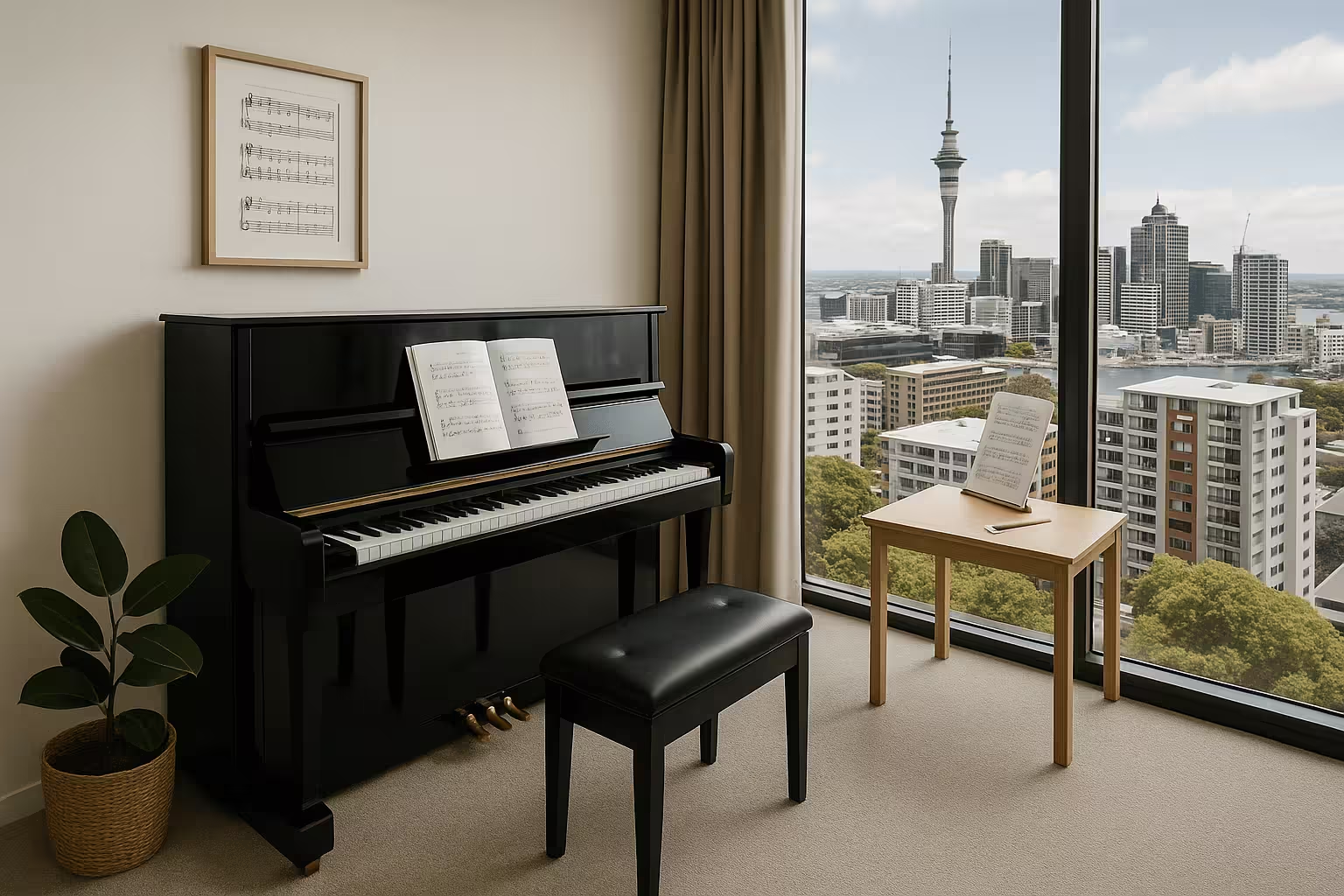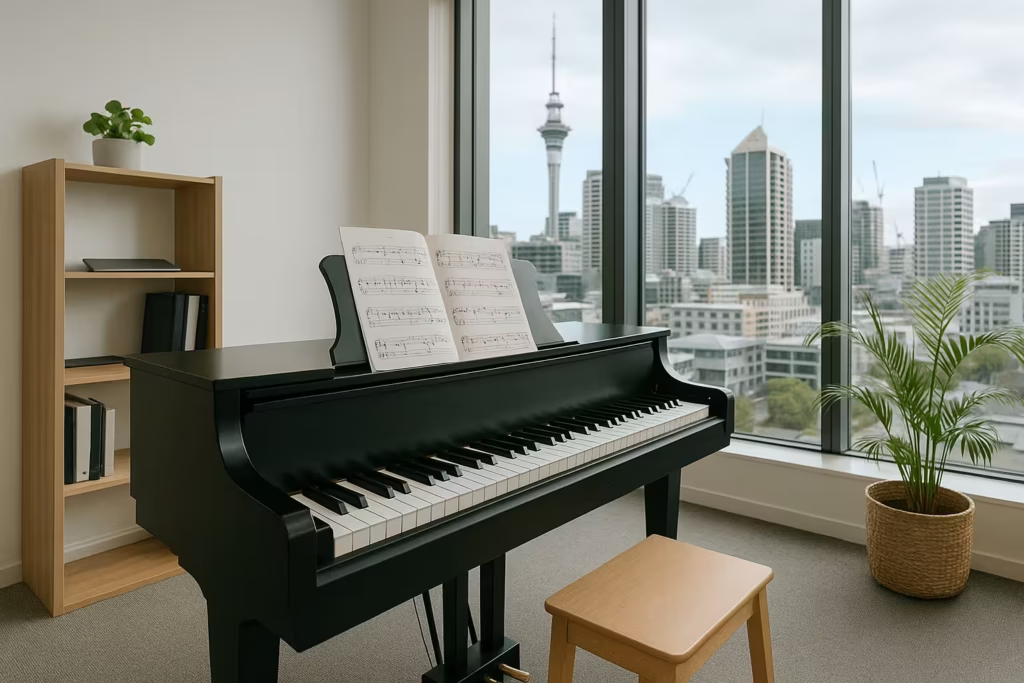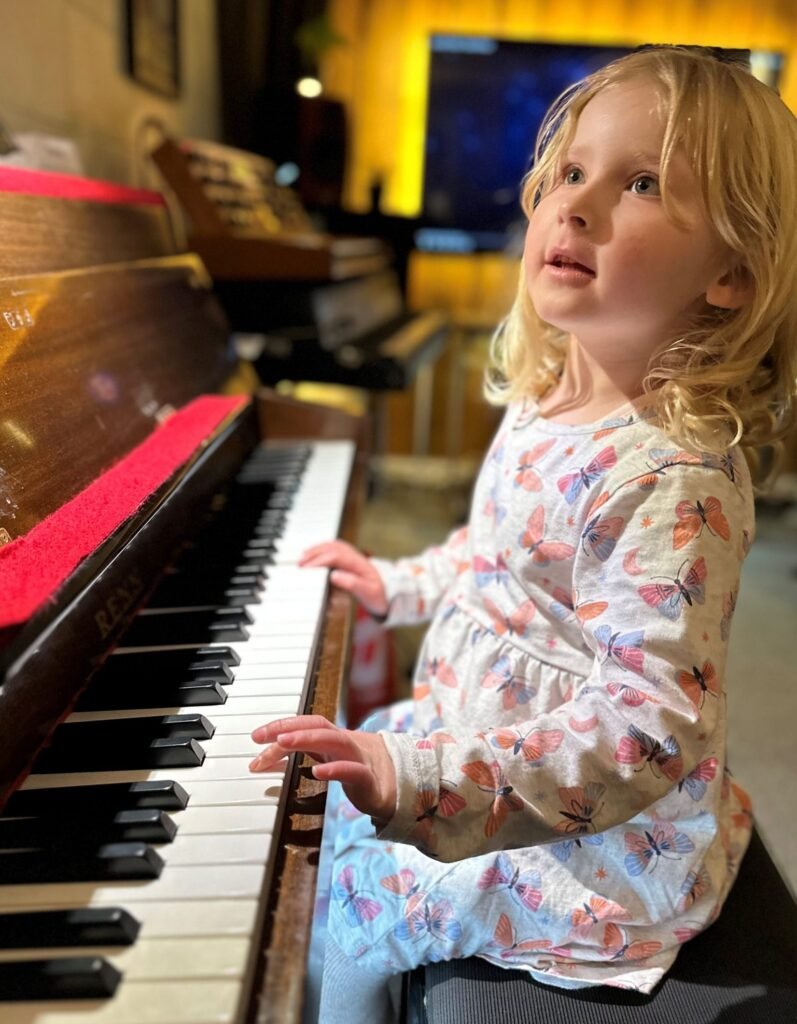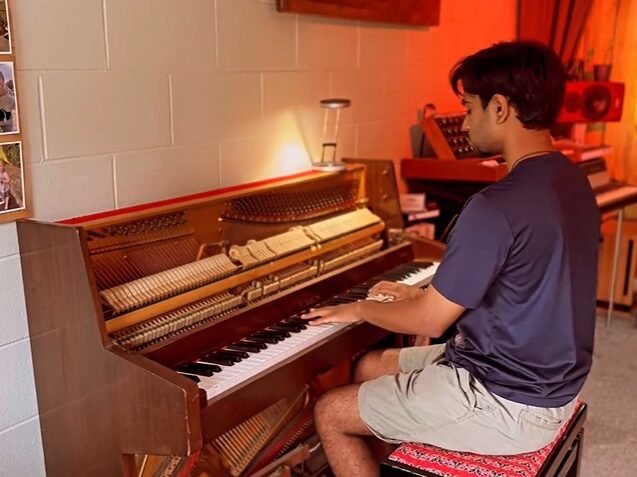Reading piano sheet music is often a challenge for advanced pianists who rely on playing by ear. Despite being proficient with pieces like Liszt’s Liebesträume, many need to revert to basics to improve their sheet music skills.
- Introduction
- Overcoming Psychological Barriers
- Strategies for Retraining the Eyes and Brain
- Why Choose Timothy William for Reading Piano Sheet Music
- Frequently Asked Questions
- Why is it challenging for experienced pianists to read music?
- What are the first steps in learning to read piano sheet music?
- How should I practice sight-reading?
- Could reading piano sheet music help with playing by ear?
- How can I track my progress in reading music?
- Do teachers in Auckland offer specific programs for this transition?
- Is it necessary to learn to read music if I am already an advanced player?
- What resources are available for adult learners?
Many pianists can perform impressive works by Liszt or Chopin, yet find themselves at a disadvantage when it comes to reading piano sheet music. Timothy William, an accomplished piano teacher based in Auckland, New Zealand, often encounters students who, after years of playing complex compositions by ear or through tutorials, are still novices in sight-reading. These musicians are comfortable with the emotional depth and technical demands of compositions such as Liszt’s Liebesträume or Chopin’s Fantasie-Impromptu, but when a sheet of music replaces familiar audio prompts, everything changes.
The Challenge of Learning to Read Sheet Music
This paradox—advanced playing skills combined with basic reading capabilities—is far from uncommon. Many pianists, caught in the charm of playing by ear, often bypass the essentials of reading music. Indeed, while it is feasible to aspire towards and perform advanced works, the ability to interpret sheet music remains a distinct skill. This shift from the comfort zone of auditory cues to visual notation often results in a necessity to revisit rudimentary material, which can initially feel like stepping backwards.
The Value of Starting Simple
This necessity to regress stems from the primary teaching insight that suggests returning to elementary pieces frees one to focus entirely on enhancing their reading skills. By simplifying the technicality, pianists can concentrate on translating notes from paper to piano keys without the distraction of complex fingerings or advanced artistic interpretation. It allows the mind to connect theoretical knowledge with practical application. For many, this backward step is an integral phase of retraining, facilitating the development of fluency in reading piano sheet music.
Encountering this predicament can be disheartening for accomplished performers. However, understanding the importance of redefining one’s approach to music with the guidance from experts such as Timothy William opens up new pathways to growth. So, how does a pianist trained in perfection prepare to embrace a novice’s eye once more? This introduction not only addresses the high-achieving musician’s common challenges but also serves as the groundwork for a structured journey through effective, supportive retraining methods.

Overcoming Psychological Barriers
Advanced pianists often find the prospect of starting over daunting, primarily due to psychological barriers. Unlike beginners, these seasoned players have set high standards for their performances. Accepting the need to step back to simpler pieces, thus, feels like a compromise of their established skills. A significant mental hurdle is the fear of judgement—whether from themselves or from others—when tackling elementary songs. Recognising that this transition isn’t a reflection of their overall musicianship but a step towards comprehensive mastery is essential for growth.
Self-Compassion and Mindset Shifts
Self-compassion plays a crucial role in overcoming the mental challenges tied to improved sight-reading of piano sheet music. It involves acknowledging the learning curve and being kind to oneself during this transitional phase. Shifting one’s mindset from “performing” to “learning” is imperative. This shift can be encouraged by setting realistic, incremental goals focused solely on developing sheet music reading skills rather than performance accuracy. Celebrating small victories, such as correctly reading a simple piece, can significantly bolster morale and motivation. Timothy William, a renowned piano teacher in Auckland, advises students to view reading practice as a means to broaden their musical capabilities beyond the immediate satisfaction of performance.
Tackling Performance Anxiety
Performance anxiety can magnify the challenge of restarting with basic material. Many adult learners face anxiety due to the fear of losing face—a concern exacerbated when returning to fundamental pieces. One effective strategy is to practice in a private, comfortable setting where judgments and interruptions are minimal. This can help pianists feel safe to make mistakes and learn from them. Additionally, gradually introducing low-pressure performance opportunities, such as casual family recitals, can desensitise individuals to performance nerves. Breaking the practice pieces into manageable sections and rewarding oneself after successful readings can also cultivate a positive experience, resulting in reduced performance stress over time. By consistently working through these routines, pianists can build the confidence needed to excel in reading piano sheet music without anxiety.
Cultivating a Growth Mindset
To successfully navigate the psychological challenges of reading sheet music, cultivating a growth mindset is pivotal. Pianists should embrace the process of learning as continuous, understanding that expertise in one area does not negate the need for growth in another. Encouraging curiosity about how music is constructed through sheet music can enhance engagement and enjoyment in the learning process. By focusing on the long-term benefits of increased musical literacy and flexibility, advanced pianists can maintain motivation. The expertise of Timothy William in Auckland supports building a growth mindset, fostering a holistic approach to learning piano, where each note on the sheet contributes to a richer musical tapestry.
This expanded understanding of overcoming psychological barriers lays the groundwork for the practical strategies needed for effective reading practice. In the next section, we’ll explore specific methods to retrain your eyes and brain to read music fluently, supporting the transition from ear-playing to comprehensive sheet music proficiency.

Strategies for Retraining the Eyes and Brain
Taking the leap from playing complex compositions by ear to reading piano sheet music can feel daunting, especially after years of honing your technical skills without focusing on reading. It requires patience, persistence, and a strategic approach to retrain your eyes and brain. In this section, we will explore actionable strategies that can facilitate a smoother transition, enabling you to become proficient at reading music while preserving the joy of playing.
Using Simplified Material
The journey back to basics might seem counterintuitive for skilled pianists, but it offers immense benefits. Selecting simplified versions of pieces or basic repertoire allows your focus to shift solely to the act of reading. By stripping down the complexity of the music, you create an environment where sight-reading can thrive. This adjustment not only makes reading less intimidating but also develops your musicality in tandem with your reading ability. Incorporating favourite tunes in a simplified format can motivate practice while gradually building a stronger reading foundation.
Building a Routine for Consistency
To foster effective reading skills, it is vital to establish a consistent practice routine. Consider starting each session with five to ten minutes dedicated solely to sight-reading. Choose pieces well within your comfort zone, where you can play from start to finish without pausing. This approach promotes fluency and reduces the tendency to revert to playing by ear. Over time, incrementally increase the difficulty of these pieces to challenge your reading ability without overwhelming your technical capacity.
Enhancing Visual Recognition
Visual recognition is a crucial component of reading music. Engaging with flashcards or music theory apps to reinforce note names and symbols can accelerate your familiarity with the score. Interspersing these exercises with regular practice helps cement your capacity to quickly identify notes, rhythms, and dynamics, streamlining the reading process. Furthermore, practising away from the keyboard, by simply “reading” through music with your eyes, can further bolster your reading capabilities.
Exercising Patience and Progress Tracking
Patience is paramount as you navigate the transition from ear-reliant to proficient reader. By setting achievable goals and celebrating small victories, motivation can remain high. Maintain a progress log to track improvements, noting any recurring challenges. This reflective practice instills confidence and highlights your journey’s milestones, underscoring how perseverance can transform your playing and deepen your appreciation for music.
The path to mastering the art of reading sheet music is paved with incremental successes and persistent effort. As you delve into these strategies, embrace the gradual growth and newfound skills that enrich your musical journey. In the next section, we will discuss why choosing Timothy William for personal guidance can further enhance your ability to read piano sheet music, offering expertise and tailored support in Auckland.
Why Choose Timothy William for Reading Piano Sheet Music
In the competitive world of piano instruction, Timothy William sets himself apart as the leading choice for pianists eager to master the art of reading sheet music. Based in Auckland, New Zealand, Timothy William has carved a niche for himself by turning complex musical challenges into accessible and engaging learning experiences. His expertise in guiding musicians from intuitive playing to confident note-reading is backed by an impressive repertoire as a teacher and pianist.
Experienced Local Experts
Timothy William leverages his local expertise in Auckland, providing personalised piano lessons that meet the unique needs of each student. Unlike many instructors who offer a one-size-fits-all approach, Timothy tailors his curriculum to support both foundational learning and advanced technical prowess. This commitment to individualised education ensures that his students can transition smoothly from relying on ear to competent sheet music reading, all while enjoying the process. Those searching for an Auckland piano teacher will find his depth of knowledge to be an invaluable resource.
What Sets Us Apart
What truly distinguishes Timothy William from other piano teachers is his innovative teaching strategy, which synthesizes the best elements of traditional and modern pedagogical techniques. By emphasizing enjoyable learning experiences and practical results, he breaks down reading piano sheet music into manageable, rewarding milestones. His dedication to student success is evident in the numerous testimonials from graduate students who have advanced from apprehension to fluency in sight-reading. Furthermore, Timothy’s approachable demeanour and professional reliability build a supportive environment where students feel encouraged to explore their full potential.
Choosing Timothy William means investing in a music education that respects your goals and time. His proven success rate and enduring student satisfaction make him a standout choice for anyone serious about mastering sheet music reading.
In our final section, we’ll delve into frequently asked questions about reading piano sheet music, providing clear answers to demystify this essential skill and empower pianists in their musical journey.
Frequently Asked Questions
Why is it challenging for experienced pianists to read music?
Many experienced pianists develop strong playing skills by ear, which allows them to sidestep the need to read music. However, this often means that reading music feels unfamiliar and complex, much like learning a new language late in life.
What are the first steps in learning to read piano sheet music?
Start with basic-level pieces that allow you to focus on reading rather than technique. This will help you build confidence and slowly integrate reading into your skill set.
How should I practice sight-reading?
Effective sight-reading practice involves playing very easy pieces straight through without stopping. Consistent practice over a year can gradually improve your fluency.
Could reading piano sheet music help with playing by ear?
Yes, reading music can enhance your understanding of musical structure and theory, potentially improving your ability to play by ear by providing a deeper theoretical framework.
How can I track my progress in reading music?
Keep a log of your practice sessions, noting improvements and challenges over time. This data can serve as a motivational tool as you see your progress.
Do teachers in Auckland offer specific programs for this transition?
Yes, many piano teachers in Auckland, including Timothy William, offer tailored lessons to help pianists transition from playing by ear to reading sheet music effectively.
Is it necessary to learn to read music if I am already an advanced player?
While not necessary for everyone, learning to read music can broaden your repertoire and enhance your overall musicianship, offering a different perspective on music.
What resources are available for adult learners?
Explore online tutorials, apps, and sheet music designed specifically for adult learners transitioning to reading music. These resources can complement lessons and enhance self-study.




